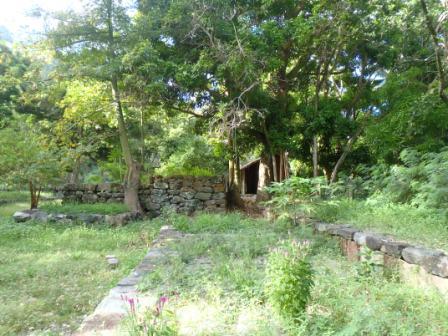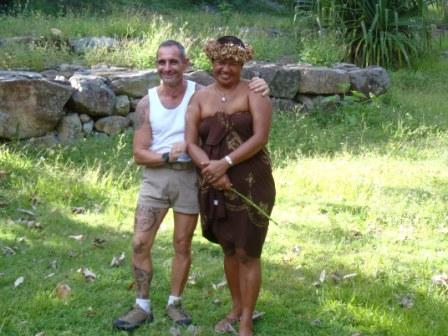The Polynesians

VulcanSpirit
Richard & Alison Brunstrom
Fri 8 Jun 2012 05:59
|
There were about 100 000 Polynesian people living
in the fertile Marquesas at the time the French arrived in 1791. Polynesians
went on from here to discover and settle Hawai'i (the glottal stop is a
Polynesian standard), Easter Island and South America. That they reached South
America, 4000nm away, is astonishing but now certain; the biological evidence is
conclusive. Modern research shows that the sweet potato Ipomoea
batatas, a native of the Americas (surprisingly to me, it's a convolvulus)
was growing in the Cook Islands by 700AD, while the coconut Cocos
nucifera, a native of the Phillipines, was growing in Ecuador when the
Spanish arrived. And the South American bottle gourd Lagenaria
siceraria was growing in Polynesia by 1000AD. It is just about
possible that the coconut reached South America under its own steam, but the
other two plants just couldn't cross an ocean. Books have been written about how
the Polynesians managed to navigate thousands of miles of ocean in canoes, but
even when you know how they did it it's still amazing and makes our modern
efforts, challenging though they seem to us, look utterly feeble by
comparison.
Polynesians were a very warlike lot, and the
Marquesans notoriously so. On European contact almost perpetual war was in being
between the many tribes, and cannibalism was normal. One school of thought
holds, persuasively, that cannibalism was due in large measure to a meat
shortage caused by religion. Polynesians had only three significant
sources of meat - fish, poultry and pigs. There were not enough fish and
poultry, and pigs although plentiful were reserved for holy feasts - so eating
each other looked like a good source of protein. The constant warfare helped of
course, but you also ate your relatives when they died (the priest ate granny's
eyes and brain raw, the tribe ate the rest). Cannibalism was still being
practised here until the twentieth century - the locals say that they went from
cannibalism to the Internet in 80 years!
But the Marquesans didn't last long after
colonisation in 1842. A small party of Marquesans was taken in slavery to Chile
in about 1860. The French sent a rescue mission, slavery having been abolished
in France, and a dozen or so were recovered. Half died on the trip back, and the
remaining six were returned to two of their native islands. Unfortunately it
turned out that they had smallpox; the consequences were devastating. A census
in 1921 showed just 2094 Marquesans; 98% had died from smallpox and influenza.
The population has crept back up to about 8000 now but the islands are full of
ruins showing just how large the population once was.
Here is a restored site;
 This was the dance arena, with thatched houses
around it. All wooden structures were built on dry-stone platforms, some very
large, called pae-paes. As the population increased these platforms became much
bigger and taller, using huge stones many of which had been brought from the
beach 3km away, a quite prodigious feat (Polynesians tended not to build near
beaches because of tsunamis).
Here is the Chief's ceremonial pae-pae, in the
centre, behind the tree:
 to the left of the chief's paepae is another lower
platform. This was used to make drums. two sorts of skin were used - shark and
human!
And here is our guide, Jerome, with a relatively
small local girl. Jerome was French army and met his French-born Marquesan wife
in France. She then inherited her parents' place and they moved to Ua Pou
(pronounced Wah Pooh) where they run a Pension and he does guiding. As you can
see he has 'gone native'. He speaks fluent Marquesan (undergoing a revival, much
like Welsh) and has got himself tattooed (although a real Marquesan warrior
would be tattooed from head to foot). In fact, he's become the local tattooist
and is in great demand.
 |